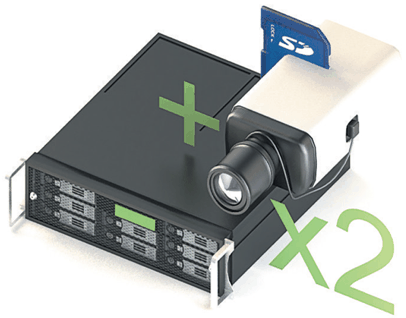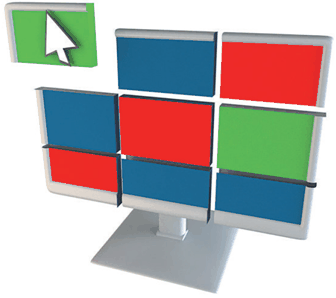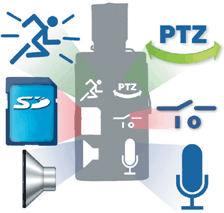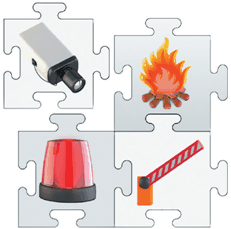TRASSIR software is a modern automated system intended to arrange video surveillance, smart processing and storage of video information, and to provide access to video data for operating and dispatching personnel.
TRASSIR covers a wide range of tasks and is the reliable base for both centralized and decentralized video surveillance systems.
The software is implemented in a web-based distributed IGMP architecture: it can run both on a single server or as a part of complex solutions consisting of multiple machines. The Clients run on separate workstations using data coming from video surveillance system and can connect to TRASSIR servers via local network or via the Internet.
TRASSIR is an up-to-date software with the following features and technologies:
TRASSIR technologies ensuring data storage reliability
MultiStor II technology increases archive depth several times by minor reduction of the archive volume in the main stream while gaining significant increase of the archive depth in the additional stream. An additional feature of MultiStor II technology is parallel recording to multiple hard drives at the same time to avoid total data loss when any of them fails.
EdgeStorage technology effectively doubles the reliability of the operation with the video archive due to the use of two independent archives in a single system.
Modern IP-devices (Network Video Recorders and IP-cameras) support archive recording to the internal HD or SD-card. TRASSIR can manage each archive separately and in case of server malfunction or communication failure the data on the device will not be lost. After the network recovery, TRASSIR will provide access to archive on IP-devices.
Video archiving. TRASSIR supports an unlimited number of hard disks for recording, making it possible to create archives with sizes in the tens of terabytes. Additionally, it supports hot-plugging of various types of digital storage devices: CDs, USB-drives and FireWire.
For each drive, there is a diagnostic system and statistics about disk space available for video archive recording; there are also a number of settings that let an administrator specify which drives are to be used and how, and how much hard disk space an archive can occupy.
Recording to the archive can be done continuously: by operator command, by schedule or by motion detector. The video archive can be securely encrypted, if necessary.
Lost channels. This function allows you to make work with the archive much easier. You can view it on any computer without any additional actions and settings. You can record the archive from the video server to an external drive, then connect it to any computer where TRASSIR is installed - and work with the archive as on a video server. You can also view this archive using free TRASSIR Client application, which requires no USB key with a license to run it.
For the channels to be created to view the archive on another computer, a term "lost" is used. Lost channels are the channels for which only the archive is available and there is no video register device (grabber).
All events of video camera surveillance system are recorded and stored in a database , which can be both on local and remote server. Data retention time is determined by TRASSIR settings.
TRASSIR Cloud is a set of free WEB services from DSSL that provide 24/7 monitoring for your servers. In addition, TRASSIR Cloud allows you to control servers from personal account and display their status on the map.
TRASSIR network features
MultiStream is a multi-thread technology allowing to significantly reduce the requirements towards the video server or customer's remote computer. The technology consists in a simultaneous receipt of two video streams from the video camera with independent settings of resolution, degree of compression and frame rate.
The first stream of maximum resolution will be used to record to archive or display on screen while full screen viewing of the video from this camera. Second stream of low resolution and decreased frame frequency will be displayed on the screen (both customer and server) in multiscreen mode. Both streams can be set up independently and the system will switch between them imperceptibly, significantly saving server and network resources for the user.
Tier is the unique feature of TRASSIR allowing you to combine servers into networks on the tree-structured principle.
TRASSIR architecture allows you to build distributed video surveillance system of any scale: unrestricted number of network clients can connect to single server, both through local network and through Internet. In addition, it is possible to combine unrestricted number of servers into single network, herewith servers can operate both independently and exchange data with each other; remote servers set up is possible through the network. And the unrestricted network administration allows you to control any TRASSIR server through the customer's software or through WEB. When you access the system via web-browser, it will be sufficient to run TRASSIR web-server- and there would be no need to install any software to arrange operators' workplaces.
Ergonomic and management features
TRASSIR open user interface allows customize your workspace using ready templates of screen separators and camera arrangement. Arrange any object at monitor screen the way you need: plans of the premises, video cameras arrangement, Access Monitoring and Control System and Operations Service event logs, AutoTRASSIR license plate recognition or ActivePOS cash control.
TRASSIR multitask operation mode performs all operations (monitoring, archive recording, archive view, settings, access via network, remote viewing of the video archive along with interaction with integrated safety systems) simultaneously in a single interface. Thus, the staff will be able to perform all necessary actions simultaneously without interruption of the other components of video surveillance system operation.
Easy navigation accelerates user operation by times.
A built-in video player is provided to review archive in TRASSIR, enabling to review fragments in any order, scroll them forward and backward, increase and reduce view speed, review frame-by-frame. It is also possible to export archive fragments to video file and make screenshots.
ActiveSearch II is an intelligent technology of motion detection in the video archive which makes operator's work much easier. At the objects with round-the-clock recording to archive, in order to search for an event, you need to review the entire video archive. With ActiveSearch it is enough to select the area in which you want to find the desired fragment and select time interval of search and in a few seconds TRASSIR will output the list of segments at which any movement had happened in the selected area.
MultiSearch significantly increases the search for events in the archive. Select the region and in a second you'll get in one scene segments from various time points of archive.
TRASSIR ActiveDome accelerates PTZ camera control 20 times. It allows performing automatic monitoring of the vast territories and zoom objects with single click.
TRASSIR has built-in search engines allowing to find the required event and if necessary immediately start reviewing the corresponding archive. Besides, the possibility to create filters for the current events is provided allowing to reduce the scope of the output data. Using filters one can achieve output of only those events that are worth operator's attention.
A mechanism of video surveillance system flexible settings is implemented in TRASSIR, using schedules, rules and scripts. Any equipment or video channel in TRASSIR can be both source of event and a performer of actions. The schedules, rules and scripts ensure management of video surveillance system response to any occurring events.
Multi-level rights distribution system is implemented in TRASSIR, allowing to prevent unauthorized access. Administrator can create user accounts with various combinations of access rights, for example: "current events review", "archive review", "archive export", "administration" (capability to change system settings), etc. up to possibility to control other user accounts.
TRASSIR integration
Broad range of supported devices. Different types of devices can operate together in a single video surveillance system: Hardware/software-based compression cards and IP devices. Additionally, TRASSIR works correctly with the majority of modern hardware platforms, and the list of supported devices is constantly growing.
The use of efficient H. 264 compression standard. This standard provides for unprecedented frame size under perfect quality. For example at 704 x 576 resolution and slight movement color frame size is 3 Kb and black-and-white half-frame - 1 Kb. H.264 provides for huge saving of disk space and allows long-term storage archives for lesser costs.
ActivePOS - integration with POS-systems. The widest possibilities of the cash control system are provided through event integration with leading trading systems. ActivePOS creates scenarios for detecting violations of any complexity, and a powerful reporting system with cash analytics will not leave scammers any chance.
Integration with Access Monitoring and Control System and Security and Fire Alarm allows you to get complete list of events from AMCS. It will provide possibility to adjust response rules, manage objects using TRASSIR maps, conduct photo and video verification and view the status of all the objects.
AutoTRASSIR automatic license plate recognition system which can be used to control the entry/exit of vehicles to/from the territory of enterprises as well as traffic control service, at the checkpoints and at any other inspection points. TRASSIR provides interaction with access control systems, video and audio surveillance systems and execution units (for example, rising arm barriers).









